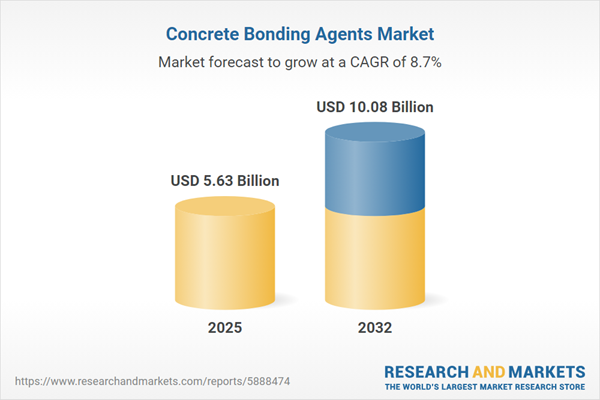Speak directly to the analyst to clarify any post sales queries you may have.
The concrete bonding agents market is experiencing accelerated innovation and evolving demand, prompting leaders in construction and chemical manufacturing to reassess strategies for both product development and supply chain optimization.
Market Snapshot: Concrete Bonding Agents Market Growth and Outlook
The Concrete Bonding Agents Market grew from USD 5.19 billion in 2024 to USD 5.63 billion in 2025. It is expected to continue growing at a CAGR of 8.65%, reaching USD 10.08 billion by 2032.
Shifting construction approaches, regulatory mandates, and sustainable practices are intensifying the adoption of advanced bonding solutions across global regions. Sector growth is underpinned by rapid urbanization and infrastructure renewal, while high-performance polymers and innovations in application methods continue to expand market potential.Scope & Segmentation of the Concrete Bonding Agents Market
This report offers a detailed assessment and revenue forecast for the global concrete bonding agents market, including:
- End Use: Commercial, Industrial, Infrastructure, Residential
- Distribution Channels: Offline, Online
- Geographic Coverage: Americas (United States, Canada, Mexico, Brazil, Argentina, Chile, Colombia, Peru), Europe, Middle East & Africa (United Kingdom, Germany, France, Russia, Italy, Spain, Netherlands, Sweden, Poland, Switzerland, United Arab Emirates, Saudi Arabia, Qatar, Turkey, Israel, South Africa, Nigeria, Egypt, Kenya), Asia-Pacific (China, India, Japan, Australia, South Korea, Indonesia, Thailand, Malaysia, Singapore, Taiwan)
- Key Companies: Sika AG, BASF SE, MAPEI S.p.A., Arkema SA, RPM International Inc., The Dow Chemical Company, Pidilite Industries Limited, Soudal NV, Fosroc International Ltd., GCP Applied Technologies Inc.
- Technologies & Trends: Waterborne systems, polymer-modified formulations, low-VOC chemistries, bio-based and recycled additives, nano-enhanced bonding agents, digital field monitoring, solutions for advanced construction methods.
Key Takeaways for Senior Decision-Makers
- The primary keyword, concrete bonding agents, anchors both growth and differentiation in global construction, especially as application requirements and sustainability frameworks advance.
- Segmented end-use needs demand tailored product portfolios, with commercial and industrial clients prioritizing rapid-curing and high-durability solutions, while residential customers seek user-friendly and cost-effective options.
- Offline distribution remains vital for expert support and immediate supply, but digital channels are expanding, enabled by algorithmic inventory, data-driven recommendations, and growing direct-to-user purchasing.
- Technological innovation in formulation—encompassing environmentally friendly additives and adaptable performance characteristics—is key to meeting evolving regulatory expectations and addressing extreme climatic and chemical exposure challenges.
- Regional variations are pronounced; for instance, North America and Europe face stringent rules and green building demands, Middle Eastern and African markets require robust resilience, while Asia-Pacific focuses on rapid build cycles and cost sensitivity.
- Supplier alliances, local manufacturing, and proactive risk management strategies are increasingly critical for navigating supply disruptions and margin pressures stemming from global events.
Tariff Impact: Navigating Procurement and Distribution After 2025
Recent tariff implementation in the United States is affecting the concrete bonding agents market by raising input costs and pushing manufacturers to diversify supplier networks. The move is driving regional production closer to end-use markets and reshaping logistics strategies. Other responses include formulation tweaks to maintain strength with more efficient raw materials, and new licensing or development partnerships to access crucial technologies locally while circumventing the highest tariffs.
Methodology & Data Sources
This market analysis uses a multi-stage research approach. It combines desk research, reviews of technical and regulatory reports, proprietary trade database analysis, and structured interviews with executives, engineers, and supply chain experts. Triangulated data validation and regular peer review underpin both quantitative and qualitative findings.
Why This Report Matters for Strategic Planning
- Delivers actionable insights on product, procurement, and channel strategies, supporting senior leaders in minimizing supply chain risk and capturing growth opportunities.
- Enables targeted portfolio development by segment and region, accounting for diverse performance, compliance, and sourcing considerations.
- Offers clarity on how competitive dynamics, technology trends, and regulatory pressures intersect to shape investment priorities in the concrete bonding agents sector.
Conclusion
The concrete bonding agents market is positioned for continued evolution, driven by regulatory complexity, sustainable innovation, and regional construction trends. Strategic adaptation and deep end-user understanding will drive value and market leadership amid ongoing change.
Additional Product Information:
- Purchase of this report includes 1 year online access with quarterly updates.
- This report can be updated on request. Please contact our Customer Experience team using the Ask a Question widget on our website.
Table of Contents
3. Executive Summary
4. Market Overview
7. Cumulative Impact of Artificial Intelligence 2025
Companies Mentioned
The companies profiled in this Concrete Bonding Agents market report include:- Sika AG
- BASF SE
- MAPEI S.p.A.
- Arkema SA
- RPM International Inc.
- The Dow Chemical Company
- Pidilite Industries Limited
- Soudal NV
- Fosroc International Ltd.
- GCP Applied Technologies Inc.
Table Information
| Report Attribute | Details |
|---|---|
| No. of Pages | 181 |
| Published | October 2025 |
| Forecast Period | 2025 - 2032 |
| Estimated Market Value ( USD | $ 5.63 Billion |
| Forecasted Market Value ( USD | $ 10.08 Billion |
| Compound Annual Growth Rate | 8.6% |
| Regions Covered | Global |
| No. of Companies Mentioned | 11 |









